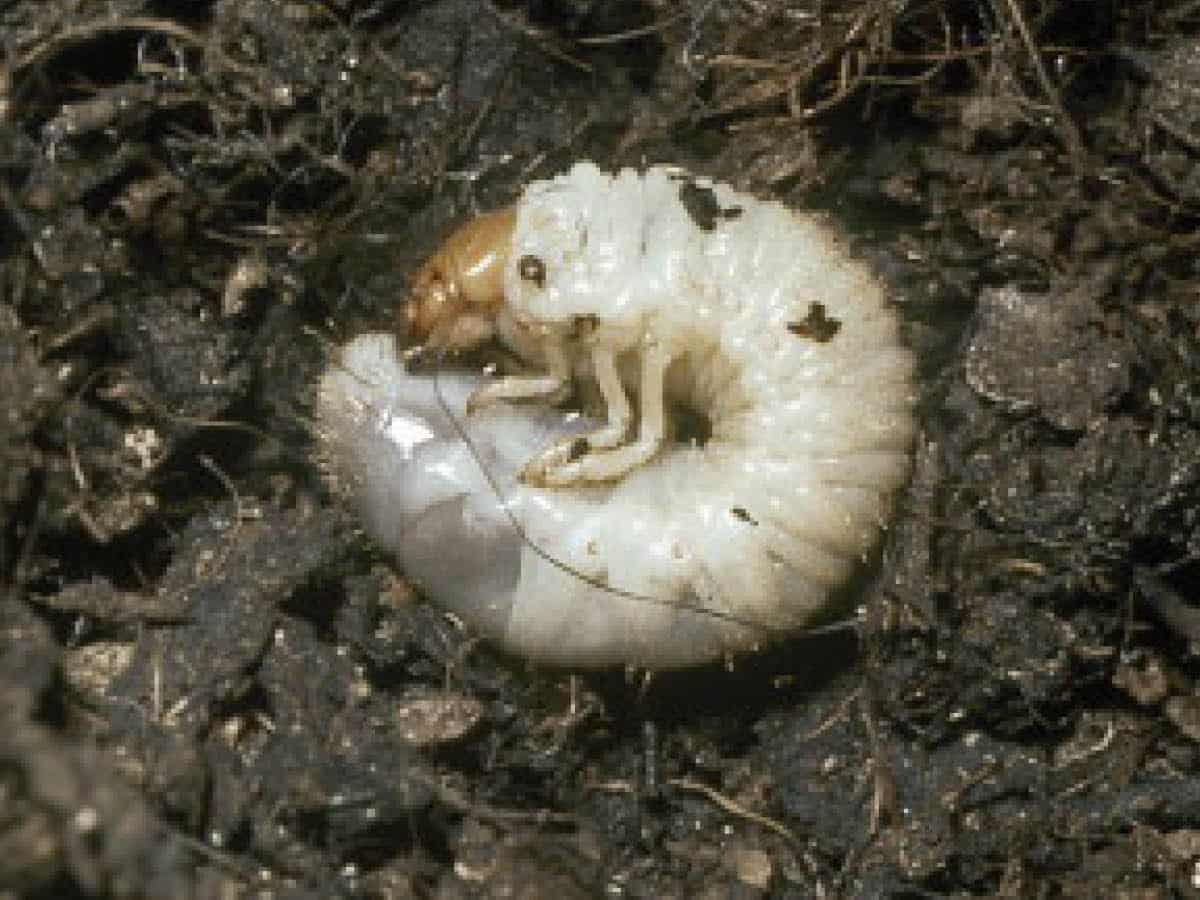
What are Chafer Grubs?
Many insects have two stages to their life. The first stage is called the larval stage. Caterpillars are in their larval stage, before becoming fully-grown butterflies. Chafer Grub is the name given to the larval stage of the chafer beetle. Before becoming chafer beetles, they are Chafer Grubs.
What do they look like?
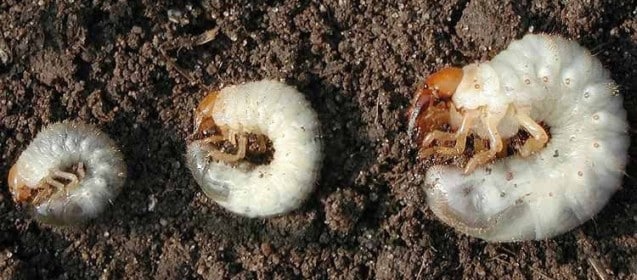
How can chafer grubs help a lawn?
Chafer grubs eat the roots of the grass plants. By doing this, they promote the growth of new, healthier roots. They also form part of the soil’s ecosystem—their cases break down into the soil once they pupate (turn into beetles), adding nutrients to the soil.
We’ve seen plenty of healthy lawns that contain small populations of chafer grubs. However, just like most other parts that make up a soil’s ecosystem, too many chafer grubs can cause damage to a lawn.
What sort of damage can they cause to my lawn?
In comparison to other grubs that reside in the soil of a lawn (for example, leatherjackets), chafer grubs can cause severe damage on lawns. Furthermore, the damage can be visible within a matter of days, and will get worse very quickly.
The damage is caused by two main factors:
- The chafer grubs – As we discovered earlier, chafer grubs feed on the roots of the grass plants. When the population of chafer grubs is balanced (i.e. not too many of them), they are beneficial to the overall health of the lawn. However, when populations increase, they will start to cause damage to the grass plants by eating too many roots too fast. The grass plants are unable to keep up with the amount of roots being eaten and will eventually die back. Unlike leatherjackets, chafer grubs eat through the roots horizontally, and will often eat a lot more roots at a quicker pace than leatherjackets. Eating through the roots horizontally causes a ‘carpeting effect’ whereby the turf can be lifted from the soil in a similar way you would be able to lift carpet from floor boards (see examples below).
- Birds/predators digging and eating the leatherjackets – Birds and other predators can be very destructive to the lawn because they dig the chafer grubs out of the soil. As the population of chafer grubs increases, so too does the damage. It is not uncommon to see large areas of a lawn ripped up and destroyed by a combination of chafer grubs feeding on the grass roots, and birds or predators digging for them.
How do I know if I have chafer grubs in my lawn?
Chafer grubs are difficult to detect until the damage has started to occur. The first signs are areas of grass starting to look yellow / brown. These areas are often mistaken for other problems such as fungal diseases or compaction.

Above: The first sign of a chafer grub infesation is areas of yellow / brown grass.
To determine if these areas of dying grass plants is caused by chafer grubs or another lawn problem, try lifting the dead grass plants. If the grass plants lift away easily from the soil, it is most probably chafer grubs. If the plants do not lift easily and are still attached to the soil via their roots, then it is most likely a different lawn problem.

Above: If the grass plants are easily lifted away from the soil and they no longer appear to be attached to their roots, the problem is most likely caused by chafer grubs.
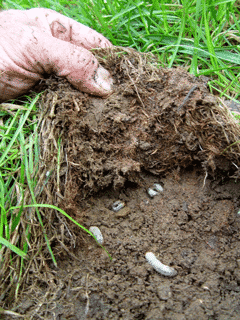
Over time, if left untreated, the affected areas will start to develop a ‘carpeting effect’ whereby the turf is easily lifted away from the soil surface. Much like carpet being lifted away from floor boards.
As the chafer grubs continue to eat the roots of the grass plants, the affected area will get bigger and bigger. In some case, an entire lawn can be decimated within a matter of days.
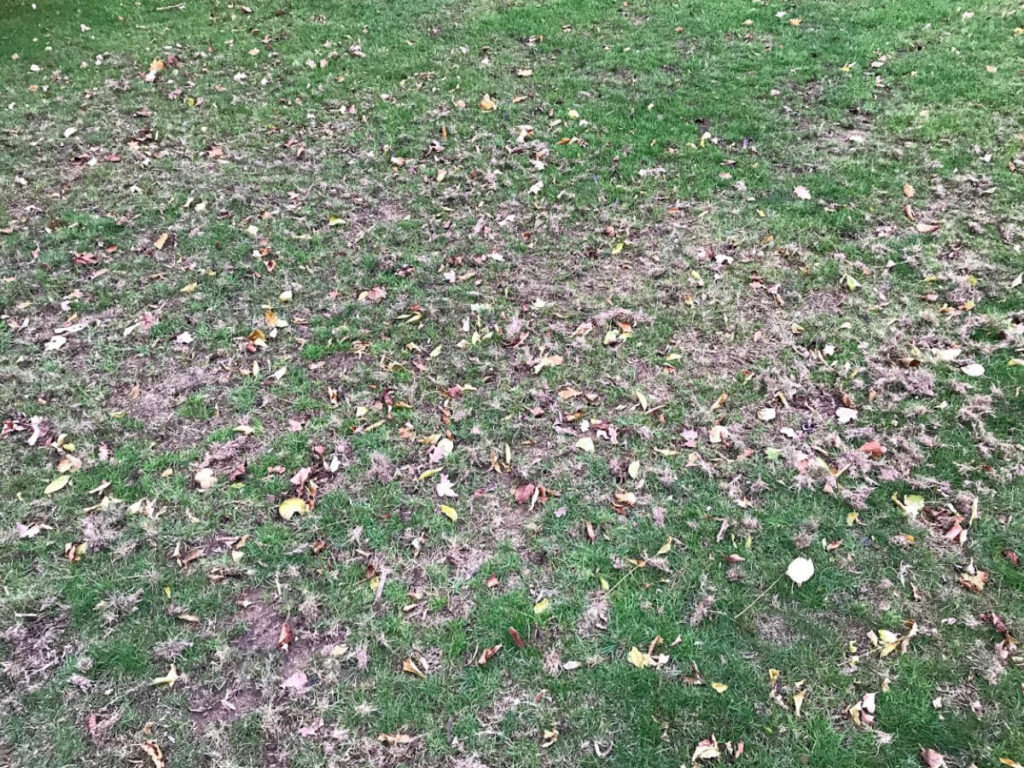

The above two pictures were taken just one week apart. The growth of the affected area and the destruction of this area was quick.
How do they get there?
During mid to late summer, chafer beetles lay their eggs in your lawn. Their eggs fall onto the soil and are burrowed below the surface by rain. Over time, the eggs will hatch and become larvae.
How do I get rid of them?
Unlike leatherjackets, as difficult as it is, the aim is to try and eradicate chafer grubs from your lawn. They are very destructive and will continue to cause havoc unless some form of control methods are applied.
The only method available is Nematodes. Nematodes are microworms that burrow into the chafer grub and feed on them. They are widely available online.
As nematodes are living organisms, you should ensure that you store them correctly, apply them at the correct time of year and in the correct conditions. Nematodes need to be applied when the soil is warm. The soil should be kept damp during application and should remain damp for several weeks after.
We recommend that you follow the instructions included in the pack for best results.
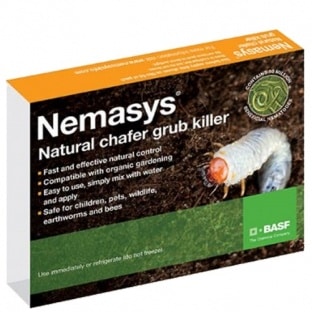
Why doesn’t Green Man Lawn Care apply nematodes as part of their service?
As nematodes are living organisms, you should ensure that you store them correctly, apply them at the correct time of year and in the correct conditions. Nematodes need to be applied when the soil is warm. The soil should be kept damp during application and should remain damp for several weeks after.
We recommend that you follow the instructions included in the pack for best results.There are many factors that can affect the overall outcome of using nematodes on a lawn, so it is important that they are applied at the correct time of year and in the correct conditions. This could mean regular watering following application. The correct time of year can change depending on the weather conditions and repeat cycles are more than likely required to get the best results. The products should be used soon after purchase or kept in a fridge as they have a limited shelf life. Bearing in mind all of these factors, we would not be able to provide a cost-effective and reliable enough service.
Why doesn’t Green Man Lawn Care apply nematodes as part of their service?
Unfortunately, the damage caused by chafer grubs is so destructive that some form of repair will be required. This will usually be a patch repair, but in some cases, the entire lawn may need to be completed renovated.
